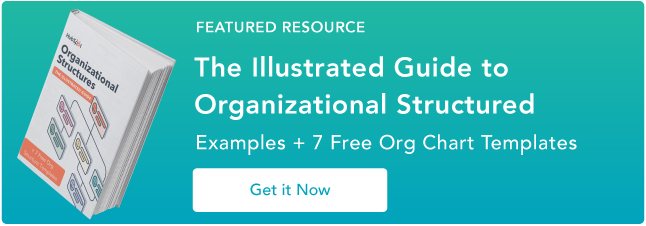Many agencies grow organically. When a new client comes onboard, a new account manager is hired. When a client asks for ongoing website work, a web developer is hired. As you can see, hiring is reactionary.

This approach is fine, but it's far from optimal when you're scaling from a team of one or two to a full staff. And as of 2022, you have to think about scaling your team in an employee's market. According to Search Engine Land, more than half a million marketers changed jobs in 2021. This great reshuffling can lead to a reshuffling of your organizational structure.
That's why it's important to plan for your hiring needs in advance using an agency org chart. In this post, we'll exactly how to organize personnel at your agency and position the team for growth years down the road.
Types of Agency Org Charts
To help you get a better view of how to design an agency organizational chart, we’ve put together a free ebook on the issue — The Illustrated Guide to Organizational Structures. In this guide, you'll see the organizational structures of inbound marketing agencies of varying sizes and specialties.
How to Design an Agency Org Chart
- Review the agency's mission and vision statements.
- Identify where your agency fits within the market.
- Outlining the communication pathway throughout the organization.
- Decide on how you'll development, promote, and retain talent in the new structure.
1. Review the agency's mission and vision statements.
Before you take your dry erase marker to the whiteboard, take a step back and think about the mission and vision of your agency. Starting here will help you understand how your leadership team should be structured and how each of the roles that report to those positions should interact with one another.
If your vision is to be the leading agency for tech startups and your mission is to bring technology-powered marketing campaigns to this market, you know that your leadership should include a technology officer and a marketing officer both of whom will work closely together to manage teams that lead the way for the agency.
Without taking a look at your agency's foundation in this way, you could end up following a generic agency org chart that puts other roles at the forefront which could lead to frustrated teams and decreased productivity down the line.
2. Decide how your agency will grow within the market.
Once you have a firm grasp on your agency's mission and vision, deciding how you'll grow will be an important next step.
In the established companies, you'll hear this concept of "product-led", "marketing-led", or "sales-led" organizations. These terms refer to the way companies decide to allocate funds and grow the business. Understanding which of these will help you meet the mission and vision of your agency is a must before you draw out your organizational hierarchy. Choosing a growth method will also help you communicate your org chart' structure and justify how you allocate headcount, budget, and other resources once the team is completely staffed.
3. Outline the communication pathway for the organization.
Your agency org structure's purpose isn't only to define who reports to whom. It should visually represent the way these teams share information and make decisions. When thinking about your agency org chart in vertical, lateral, and cross-functional terms, you'll find opportunities to either add positions that foster communication or remove bottleneck roles that perpetuate silos.
Pro Tip: As your agency grows, you may find more of these opportunities, so don't be afraid to reassess how the structure is working and adjust it accordingly.
4. Decide on how you'll develop, promote, and retain talent in the new structure.
Now that you've covered the intangible parts of your agency org structure, you'll want to brainstorm how this org chart will operate as a living part of your business strategy. Developing, promoting, and retaining talent shouldn't be an afterthought. As you're designing it, consider how your org chart supports the growth of the people in these roles.
To do this, you can decide whether your org structure will be flat or tall. This will determine how people will progress in their careers at your organization. If you have a flat structure, you can hire candidates who have aspirations to learn many facets of a marketing agency and will gladly progress laterally through departments. A tall structure is great for agencies that want to grow talent and promote from within as this structure encourages upward mobility.
Create the Perfect Agency Org Chart
Designing a company organization chart is no easy task. You can take a functional approach, where you organize people based on their job duties. You can also organize your staff around programs or initiatives. Most likely, you will create a document that is evolving and a combination of different models. In the end, it should work for you and your staff, and it should prompt you to consider on a regular basis how you want to grow and how you will grow your staff.
Editor's note: This post was originally published in June 2015 and has been updated for comprehensiveness.
![→ Download Now: The Illustrated Guide to Org Charts [Free Guide + Templates]](https://no-cache.hubspot.com/cta/default/53/7cbd0328-6c8c-40e0-98dd-c3b6e6be96f0.png)










![8 Marketing Skills You Need to Land Your Dream Job in Ad Land in 2015 [SlideShare]](http://cdn2.hubspot.net/hub/53/file-2209554110-png/00-Blog_Thinkstock_Images/marketing-dream-job.png)
